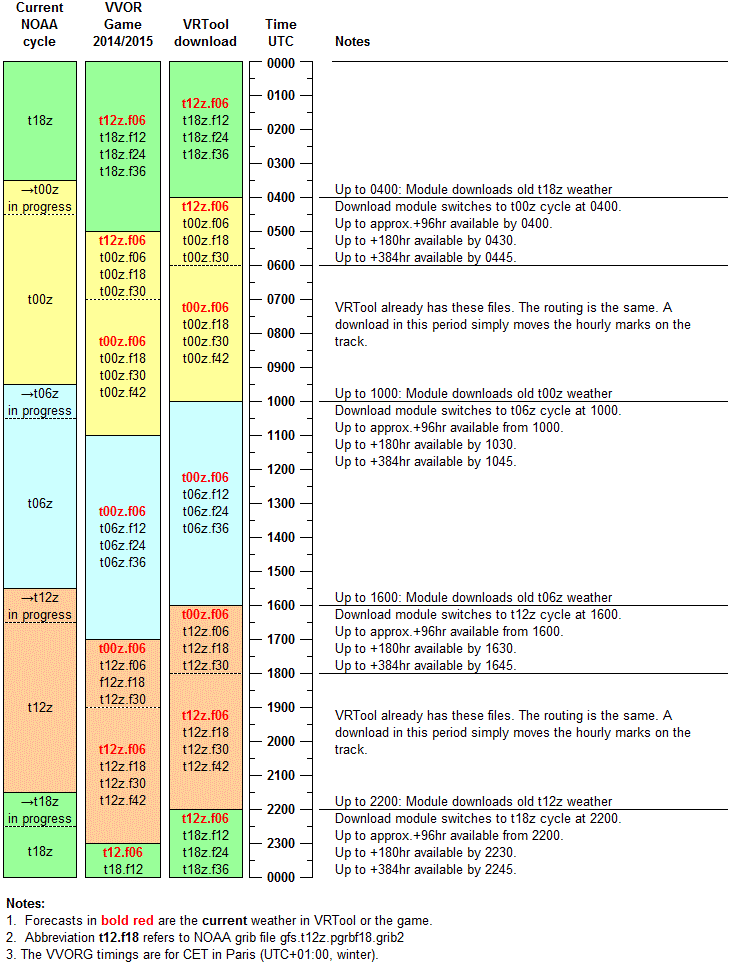NOAAWinds
Contents
NOAA GFS weather forecasts
Almost all games and weather routers get their weather information from NOAA's Global Forecast System. The GFS makes the forecasts available at this location:
http://nomads.ncep.noaa.gov/cgi-bin/filter_gfs.pl
Each 6-hourly GFS cycle predicts wind at 1° latitude/longitude resolution, at 3 hour intervals up to 192h, then at 12 hour intervals up to 384h. This data is generated by a weather simulation program, using laws of physics and inputs from instruments. Server responses are in grib 2 format. Variable "wind at 10m" is used. Winds are given by its two U and V components, in latitude/longitude directions.
A new folder is created on the NOAA server for each 6-hourly cycle. The folder is named to identify the GFS cycle using the format gfs.YYYYDDMMHH. For example the folder for a 12:00 UTC cycle might be called gfs.2014301012. For convenience this is usually referred to as a t12z cycle.
Grib files are added gradually to current folder as the GFS run proceeds. Grib files are named to identify how many hours in advance the grib applies, using the format gfs.tHHz.pgrbfhh.grib2. For example the +36 hour grib in a t12z GFS cycle is named gfs.t12z.pgrbf36.grib2. For convenience this grib is usually referred to as the f36 grib.
The first grib in each folder (the f00 grib) is already history, and is provided as an interpolation point (in time).
The publication schedule is:
Cycle Start Finish t00z 03:30 04:30 UTC t06z 09:30 10:30 UTC t12z 15:30 16:30 UTC t18z 21:30 22:30 UTC
The current production status for each run is available at this location:
http://www.nco.ncep.noaa.gov/pmb/nwprod/prodstat/
Look for the following entries in the GFS tables:
- T382 FORECAST F00-F180
- T190 FORECAST F192-F384
How Virtual Regatta games apply NOAA GFS gribs
Virtual Regatta Games use gribs from only the t00z and t12z GFS cycles.Game winds applied at 08:00 CET game time are extracted from the t00z cycle. Winds applied at 20:00 CET are extracted from the t12z cycle.
The current weather in the game uses the f06 grib; the +12h forecast uses the f18 grib and so on.
How VRTool applies NOAA GFS gribs
VRTool always downloads the latest available gribs except that it "hangs on" to the t00z.f06 and t12z.f06 gribs for 12 hours so its current weather matches the game's. (This is clearly not right for "real life" modelling and navigation, but as of version 2.31 there is no way to change this.)
The following table shows the relationship between the NOAA production cycle and VRTool's grib management. The middle column shows the timing sequence for the 2014/2015 VVOR - this is subject to change by the game organisers.
To ensure that VRTool has the most recent predictions you should download NOAA gribs right after the following times: 04:00, 10:00, 16:00 and 22:00 UTC, and recalculate your route. This will generally give you the forecasts an hour or more before they appear in the game.
| Tip: VRTool's download module switches to the new GFS cycle at the UTC times stated above. The early gribs in the cycle are available some time before this. You can make VRTool switch to the new cycle earlier than it should by tweaking the time zone setting in the NOAA download module. If you tweak it too far the download probe won't find anything. |
If you do a further download when the current weather in your game updates you will not get anything new. VRTool already has the gribs from the earlier download and the routing doesn't change. All that happens is the annotations on the tracks adjust forward by 12 hours.
Getting long-range forecasts
The NOAA GFS produces long-range gribs out to 16 days in the future. VRTool can import these, but only during the following hours:
- 10:45-16:00 UTC
- 22:45-04:00 UTC
The reason for this is as follows: Each 6-hourly GFS run predicts wind at 3-hour forecast intervals up to 192h and then at 12-hour forecast intervals up to 384h. So each run produces a sequence of grib files with the following time-stamps:
f00, f03, f06, f09 ...... f189, f192, f204, f216 ...... f360, f372, f384
|<-------3-hour intervals--------->|<---------12-hour intervals--------->|
When VRTool is set to import weather at 12-hour resolution it automatically chooses the appropriate gribs from the current GFS run. If you look carefully at the table in the preceding section, in the third column you can see that the time-stamps that VRTool selects change depending on which GFS run is being used.
For example between 04:00 and 10:00 UTC (the yellow part of the column) VRTool probes the t00z GFS run, and chooses the f06, f18, f30, f42 ..... gribs from that sequence. Beyond f192 VRTool will not find matching gribs unless it is selecting time-stamps that are multiples of 12.
This means that forecasts out to f384 can be imported only when the t00z or t12z GFS run is current (during the green and blue parts of the table), and only after the GFS run is fully completed.
